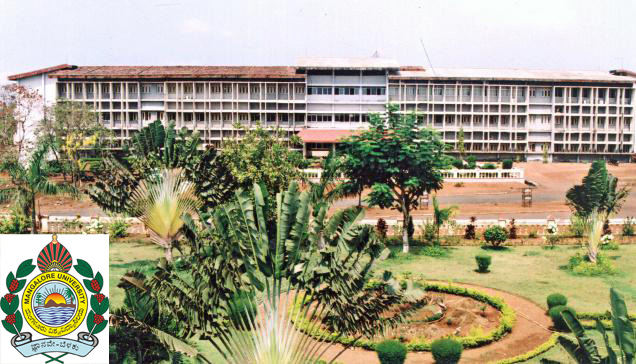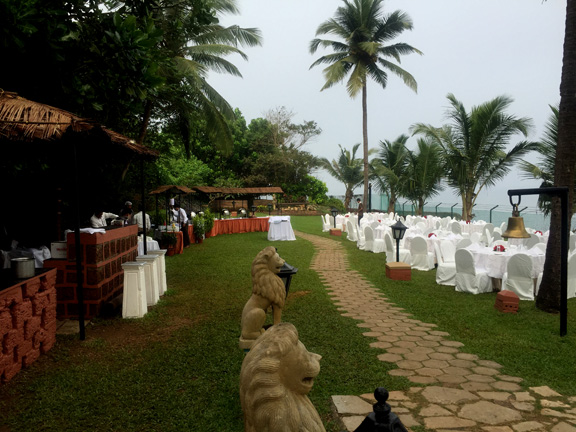
PREFACE: In 1998 I spent several months as a Fulbright Fellow in India, specifically at Mangalore University. Mangalore is a city on the western coast, in Karnataka.

Two weeks after I arrived the Fulbright Office held a conference of all the Fellows in country at the Fort Aguada beach resort in the town of Goa, several hours north of Mangalore. The observations and comments here are based on my experience at that meeting in early February, 1998, about two weeks after my arrival.
February 2, 1998: Ground Hog Day
That was the day I sang for my supper, i.e. the first day of the sessions for the Fulbright Mid-Year Conference. This event was held at the Fort Aguada beach resort in Goa. The resort is not the "real India" in any way, shape, or form. It's a 5-star hotel.

The scientific speakers went first (presumably to get rid of us as soon as possible) and then various other disciplines. We speakers were to talk not so much about what we were doing but of our experiences in India and the interactions we’d had. P.J. L—, Director of the United States-India Educational Foundation (USEFI) and more than little bit of a windbag, led off with opening remarks and then we all of us took our turns.
I went second, after the token engineer. Having done not much in the previous 10 days, I could only give them the Who, the What, and the Why: Who I was, What I planned to do and had done so far, and Why I chose India, citing for the last section the fact that I had contacts there (among them a relative) and several colleagues from India, specifically from Mangalore. My joke that the Mangalorean rickshaw drivers were ex-Kamikaze pilots who had never had the chance to make a flight went over well, and when I had finished my 10 minutes of minimal fame, P.J. gave me the thumbs-up, and later commented that I had “hit just the right note.”
It was pretty much routinely boring for the rest of session one, and after the break we came back and it was revealed to me that my impression of Fulbrighters as serious scholars needed revision. For the most part, they were are a bunch of pretentious, trendy-lefty academic blowhards. I say this in the full knowledge that probably most of the others here would say the same things about me. Several of them were “independent scholars” (described in the program under “US University Affiliation: At Large” which means, I think, they're unemployed) especially the painters and a woman who was a "textile artist."
P.J. started off the second set with a gloom-and-doom message that the USEFI program in India was being cut, and we needed to start making noise about it. Immediately one woman (a faculty member from—where else?—Berkeley) who described herself as “...a grass-roots activist; I can’t see ten people in a room without wanting to circulate a petition” started circulating a petition we were all supposed to sign to send to someone or other about how dare they cut off this vital program, etc., etc. I have no idea what this woman's area of "scholarship" might have been.
That out of the way, the second set of presentations began, and pips they were. The "textile artist" had spent months in some filthy cottage in Outer Duckboard or Utter Perish “learning the craft of dyeing and printing cloth” and so forth; she was followed by the sociologists, the anthropologists, and the ethnomusicologists.
What possible justification can there be for US taxpayers to pay some graduate student to spend 3 months in India learning Sanskrit poetry or Carnatic music? Yes, there was one of those: a young man who subjected us to classical Indian music of the "they're-pulling-out-my-fingernails-without-anaesthetic" school, and apparently did a pretty good job of it, despite sounding to me like a cat in heat. Nevertheless his diction was criticized by Rajni N—, one of the USEFI employees from the Delhi office. It seems the lad’s father had been one of the great Carnatic musicians until, alas, he was killed 15 years before by a drunk driver. Dad was still spoken of with awe in the circles of Carnatic music...though he was, in fact, a Yank. His son was following in the footsteps of the father.
Then there was the Indian-descended artist who paints mural-sized canvases in a style reminiscent of subway graffiti crossed with Grandma Moses. Terrible stuff, but his slides drew gasps of appreciation from the assembled intelligentsia. This particular stud showed up in a turban and pants suit, his long black locks and beard flying, dressed as if he were a Rajasthani, which I suppose he is—in the same sense that I’m an Italian.
But the prize of the day went to a lady—I use that term loosely, and suspect she'd be offended by it—who was (and may still be) a faculty member at NYU. This woman, a tubby 50-year-old Feminazi and self-described “antiwar activist” came to India to enlighten the natives with the joy of tap dancing, “...because native Indian rhythms are percussive and so it’s something they would take to naturally.” She ended the session with a tap-dance-cum-stand-up-comedy routine about how the Jews invented tap dancing, the nastiness of men, her own anxieties, her sex life (or lack thereof) and so forth. Tap dancing for peace and love and fraternal feeling, she was, all 180 pounds and five feet of her.
After this first day of the festival of love, peace, and condescension was over, we retired to the yard for a big lawn party.
I will say this for USEFI, they do themselves proud, oncoming budget cuts or not. We had quite a feast: prawns, Mexican beef (I suppose it might have been beef but we were, after all, in India so maybe not), seekht kabab, the works. Open bar, help yourself, and we were entertained by a “cultural event” consisting of some sprightly Goan folk-dancing to which no one paid any attention, since we were all busy drinking and eating on John Q. Public’s tab.
 I spent most of the evening with a fellow from Laramie WY, who in spite of his being a sociologist seemed a decent sort, and his very attractive wife, telling jokes and anecdotes and leaving them helpless with laughter. There were fireworks in our honor, and a birthday cake because the fat tap-dancer and one other "scholar" (I forget his field) had a birthday that day. I also rubbed elbows with Bill P—, the USIS Director in India who was a Big Cheese at the Embassy; as well as a USIA person from the States who was noticeably jet-lagged but gamely hanging on with the help of Kingfisher Beer.
I spent most of the evening with a fellow from Laramie WY, who in spite of his being a sociologist seemed a decent sort, and his very attractive wife, telling jokes and anecdotes and leaving them helpless with laughter. There were fireworks in our honor, and a birthday cake because the fat tap-dancer and one other "scholar" (I forget his field) had a birthday that day. I also rubbed elbows with Bill P—, the USIS Director in India who was a Big Cheese at the Embassy; as well as a USIA person from the States who was noticeably jet-lagged but gamely hanging on with the help of Kingfisher Beer.
The on the second day we had to get up and do it again, and with feeling. I was supposed to be up and at ‘em in the morning for the rest of the “serious” program, followed by an extravagant lunch, a boat ride, and a scenic tour of Old Goa, not to mention the dinner the taxpayers were buying me. I didn't want to disappoint them, but...
February 3
...I woke up with a cold, which did not improve the prospects of sitting through another few hours of academic pomposity. But what can’t be cured must be endured, so I did both.
Despite my cold, that morning I sat there stolidly while various people puffed and bowed, but I paid no attention to much of it (and I wasn’t the only one whose mind was wandering). After the presentations we had a session on the administrative aspects of the program, and P.J. spent a long time discussing the finances of it; any number of people expressed their outrage that the nasty, wicked, old Republican dominated Government (remember, this was in 1998) would even think about cutting the program back, yada-yada-yada.
Then it was time for the last formalities, including lengthy and boring speeches from: 1) P.J., a man who never uses one word when six are available; 2) the Fulbright Chair from Sri Lanka; 3) the representative of the University of Goa; 4) the man from USIA in Washington, more or less over his jet lag, who swore that the conference was an excellent and perfectly legitimate use of tax money; plus 4) Bill P— the India Director of USIS, and one or two others I’ve forgotten.
I had hoped that would be it over so I could have lunch and some sleep, but no. At that point it was time for weepy farewells to one O.P. B— the USEFI Fiscal Director, who was retiring. India has, it seems, a mandatory retirement age of 58! The theory is that people should move over and let someone else have a job. This is a legacy of their socialist heritage, no doubt. In any event, O.P. had been with USEFI from the beginning. There were tears all around from his colleagues as they paid him tribute; there were even tears from one of the Fulbrighters, whom I’m sure never met him in person before the conference—if then—but who looked to be the sort of woman who’d cry at a wedding even if she didn’t know the bride.
Finally it was over.
I had to think long and hard about whether or not the Fulbright program really is a legitimate function of government in the first place, and whether I can in good conscience regard it as anything more than a waste of money. Undoubtedly there are “benefits” in the sense of cultural interchange, but (even assuming for the sake of argument that cultural interchange is a Constitutionally-authorized action of the Federal government) whether or not the return on investment is enough to justify what it costs is a different matter.
I have to say that if the average American could have been there he’d have been incensed at the enormous expense involved and by the utterly ridiculous “projects” that were supported by tax dollars—that extraordinarily silly tap-dancing "scholar" in particular. Perhaps it’s time to think about just exactly what the long-suffering taxpayer is supposed to be getting for his money. If Mr. and Mrs. Average American realized that they're paying to send tap-dancing missionaries to enlighten the heathen, they would get in touch with their Congressman PDQ and demand to know why. And if they could have seen the spread we were served and the rest of it, they’d have blown a fuse.
There is no doubt that most of the "scholars" are talented people, very capable at what they do, but whether what they do is worth doing, and most especially whether it’s something the US Gummint should support, is another story. I enjoyed the event but I came to realize that the Fulbright program is mostly utter bullshit, and that if what I saw is a fair representative of “scholarship” in America, we’re in big trouble. Tap-dancing? Fabric art? Carnatic poetry? I wonder if there are or will be any rap musicians and break-dancers getting Fulbrights? Probably.
| HUNTING | GUNS | DOGS |
| FISHING & BOATING | TRIP REPORTS | MISCELLANEOUS ESSAYS |
| CONTRIBUTIONS FROM OTHER WRITERS|
| RECIPES |POLITICS |